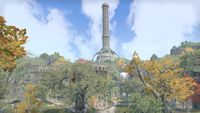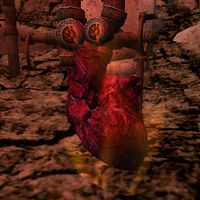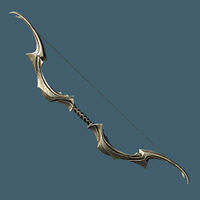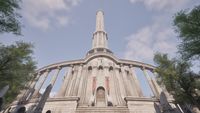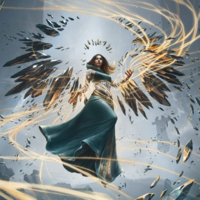Lore:Convention
—Pocket Guide to the Empire, Third Edition
Convention, also known as the Moot at the House of We,[UOL 1] was an event during the Dawn Era that took place on the Adamantine Tower, a meeting of the et'Ada outside aurbic time during which the physical, temporal, spiritual, and magical elements of Nirn and Mundus, as well as the laws that govern them and determine the role of all spirits within them, are believed to have been set in place.[UOL 2][1][1] Convention has been described as an "impossipoint".[UOL 2] The Ehlnofex war has been described by some sources as being the same event as Convention told in a different manner.[UOL 3]
The Flight of Magnus[edit]
According to legend, when Magnus, the architect of the plans for the mortal world, decided to terminate the project, the gods decided to convene at the Adamantine Tower to decide on what to do.[2] Most of the spirits departed with Magnus, becoming the Magna Ge. But some Aedric spirits chose to stay on Nirn after Magnus and the Magna Ge departed in order to keep working on the new world so it'd remain viable. Among those spirits, some, typically referred to from that point on as "Earthbones", are thought to have followed the example of Y'ffre, giving themselves to the Mundus fully to stabilize it and form the foundation of its natural law as the "bones of the earth", eternal laws of nature. While others, typically referred to from that point on as "Ehlnofey", are thought to have chosen not to give themselves fully but to populate Nirn instead, thus becoming the progenitors to mortal life, which arose from their lines and took on its current form due to a phenomenon of gradual diminishment, of each consecutive generation becoming weaker and more removed than its progenitors in stature and might. [2][3][4][5][UOL 3]
The Convention[edit]
Auri-El-that-is-Akatosh is said to have returned to Nirn from his Dominion Planet, signaling all Aedra to convene at a static meeting that would last outside of Aurbic time. The Time God's sleek and silver verssel became a spike, attached to the changing earth at one of the joint-points where the Earthbones on which the physical flesh on Nirn was hung met, and radiated a "palpable reality",[6] the "glimmerwinds of its impact" warning that any spirit that entered aura with it would become recorded. That by consent of their presence, their actions here would last a period of time unassailable, and would remain so whatever might come later to these spirits, even if they rejoined the aether or succumbed willingly or by treachery to a sithite erasure.[2][UOL 2]
The outcome of the Convention was twofold.
The spike of Ada-Mantia and its Zero Stone are said to have dictated the structure of reality within their Aurbic vicinity, defining for the Earth Bones their story or nature within the unfolding of the "Dragon's (timebound) Tale", and so setting in place the laws that govern the mortal world.[7] Thus also imposing certain limits on the "architect-gods" who, prior to that point, were "young", much like the world they'd crafted, and so held "every power at every time amendment at every ordering", making them mighty but also unable to ever fully manifest themselves within the world.[UOL 2]
Lorkhan was judged, his Heart torn out by Trinimac,[2][3] or per some sources spat out by Lorkhan himself,[UOL 1] and fastened to an arrow fired from Auriel's Bow, to land where no aspect of the new world could ever find it, after it became clear its link to the new world made it impossible to destroy.[2][3] In the removal and landing of the Heart, the second Tower, the Red Tower, is said to have been created, with the Heart itself as the First Stone. This allowed Mundus to exist without the full presence of the divine and granted it a special kind of divinity, which is called "NIRN", the "consequence of variable fate".[UOL 2]
Finally, the Aedra elected to make their exit from mortal affairs, "leaving the terrestrial sphere in their excess, for its own good", due to the danger their continued presence posed to the mortal world, which was rendered highly unstable, and even to the timeless continuity of existence. With the departure of magic in the mythic sense, linear history could finally begin, and the Dawn Era ended.[UOL 2][2] Even after the Aedra departed, Ada-Mantia continued to dictate reality in its vicinity, bringing unrelenting order to the chaos of the Dawn.[7]
A different view of the events of Convention is present in the beliefs of the Mythic Dawn. According to them, the mortal world was actually the Oblivion plane of Lorkhan, who was actually a Daedric Prince. Per this belief, the Aedra, the gods mortals generally worship, were actually Lorkhan's betrayers, who stole the realm from its true deity and intentionally split Lorkhan's progeny from their divine sparks, so that they themselves would be viewed as the sole exit from the current world. Mankar Camoran names this the "First Tower Dictate", which he describes as "render the mutant bound where he may do no more harm. As God of the Mundus, alike shall be his progeny, split from their divine sparks. We are Eight time eight Exarchs. Let the home of Padomay see us as sole exit".[8][9][10]
Aftermath[edit]
Aldmeris is said to have witnessed the events of Convention, inspiring them to create other Towers in the Merethic Era once they understood that different Towers with different Stones could "tell different stories", each following its own rules inscribed by their Variorum Architects and thus establishing their own areas of influence that they'd shape.[UOL 2][7]
The Ayleids in particular are said to have built their Tower, the White-Gold Tower, in "open emulation of Ada-Mantia" itself, thus granting it even greater power than the rest when it came to altering reality. In addition, the White-Gold Tower was meant to counteract the spiritual bleeding from Mundus caused by the Convention by serving as a focus point to reconnect the mortal realm with the divine.[UOL 2][7] The White-Gold Tower's Stone was the Chim-el Adabal, said to have been formed from a drop of blood that fell from the Heart of Lorkhan as it sailed across Tamriel, which subsequently fell into an Ayleid Well and was crystallized by the magicka within, before being cut into a diamond shape by the elves.[7][11][12]
At maturity, every Direnni of high blood is brought into the Adamantine Tower, conducted to the Foundation Vault, and shown the Zero Stone. During the ceremony, they are allowed to touch it once so they can feel the transcendent mystical power that courses through it.[13]
Interfering with Mundus is generally considered to be off-limits for the Aedra since the end of the ages of myth and, as a result, they tend to no longer respond to mortals directly. As such, though minor Aedric spirits do exist, they are rarely encountered since the moment Magnus withdrew from the world during creation.[14]
Numancia[edit]
The Ayleid religious text The Nine Coruscations claims that, when the Magna Ge, and later Daedric Prince, Ithelia was shown the Infinite Abyss and the Indeterminate Sea (Mora Obscura), she discovered the Indefinite Limits of Lorkh-Apeiron. Thus she realized not only the harmony within duality that exists beyond the simple dichotomy of Anui-El and Sithis, but that this unity of opposites contained starlight and endless possibility beyond cosmic interplay. Ithelia was thus named "the Colors of Light", who saw the "madness of the Time God" and the "first challenge of his shadow", who in nothingness saw those endless possibilities first. Ithelia saw that linear time was layered upon endless possibility by the afixing of Ada-Mantia and its Zero Stone, a stable spire afixed by a stone of nothing possible,[UOL 2][2][7] and thus did Aka disappear in the South and learn why his insanity is all that is and could be. From this lesson, the Prime Archon endeavored to cleave a path through the everything to reach Numancia. The goal of her Ayleid followers was to use violence against Man to bring forth a Numinous Paravant, whose metaphysical nature would give them unbound hands and the ability to achieve Ithelia's goal, to break the shackles of fate and give every being the world and history they desired.[15][16]
Notes[edit]
- If, as some sources claim, the Ehlnofey war is the same event as Convention told in a different way, than at least some of the Daedra might have witnessed it,[UOL 3] as it is said that the earliest martial discipline of Nirn was the "Prismatic Vector Dance of the Ehlnofey", which was recorded and studied by the Demiprince Fa-Nuit-Hen.[17]
- Some myths seemingly ascribe a degree of involvement in Dawn Era events to Daedric figures. One pre-Riddle'thar Epiphany Khajiit myth claims that, when Magrus fled from Boethra and Lorkhaj, one of his eyes was torn out, and so he could only see out of one eye and fell into the Moonshadow.[18] However, as Convention as an event is not directly described in those myths, whether a connection exists remains unclear.
- Some myths suggest the events of Convention might repeat in a cycle, possibly alluding to the concept of Kalpas, with the chaotic Dawn Era taking place between the end of the previous world and the beginning of the next one. In the mythic account described in Shor Son of Shor, the gods are described as warring with one another in a number of cycles, with the same events repeating in each. In the text the god Shor is described as consulting the ghost of his "father", the Shor of a prior cycle, in the "underworld", and repeating those same actions in the current cycle.[2][UOL 1]
- Wandering Spirits recounts the tale of Akha, who vanished in the South, with Alkosh, who has himself been described as both weaver and embodiment of time's all-encompassing tapestry,[19] appearing in his place, and bearing his crown and rule of his kingdoms across the Many Paths. This event might be the same as the disappearance of Aka linked to the afixing of Ada-Mantia that Ithelia is said to have witnessed, from a different cultural perspective.[20]
References[edit]
- ^ a b Pocket Guide to the Empire, 1st Edition: High Rock — Imperial Geographical Society, 2E 864
- ^ a b c d e f g h Before the Ages of Man — Aicantar of Shimerene
- ^ a b c The Monomyth
- ^ The Mystery of Artaeum — Penewen, Advisor to the Court
- ^ The Annotated Anuad
- ^ Subtropical Cyrodiil: A Speculation — Lady Cinnabar of Taneth
- ^ a b c d e f Aurbic Enigma 4: The Elden Tree — Beredalmo the Signifier
- ^ Mankar Camoran's dialogue in Oblivion
- ^ Mythic Dawn Commentaries — Mankar Camoran
- ^ Mythic Dawn Commentaries 3 — Mankar Camoran
- ^ The Chim-el Adabal — Mannimarco
- ^ Chim-el Adabal: A Ballad
- ^ Once — Beredalmo the Signifier
- ^ Phrastus of Elinhir Answers Your Questions — Phrastus of Elinhir
- ^ The Nine Coruscations — Star-Queen Varalias
- ^ Ithelia's dialogue in ESO
- ^ Lord Fa-Nuit-Hen and Tutor Riparius Answer Your Questions 2 — Fa-Nuit-Hen and Tutor Riparius
- ^ The Sky Spirits — Amun-dro, the Silent Priest
- ^ Ja'darri's dialogue in ESO: Dragonhold
- ^ The Wandering Spirits — Amun-dro, the Silent Priest
Note: The following references are considered to be unofficial sources. They are included to round off this article and may not be authoritative or conclusive.
| |||||||||||||||||||||||||
